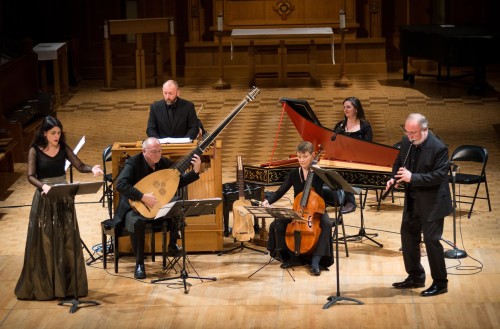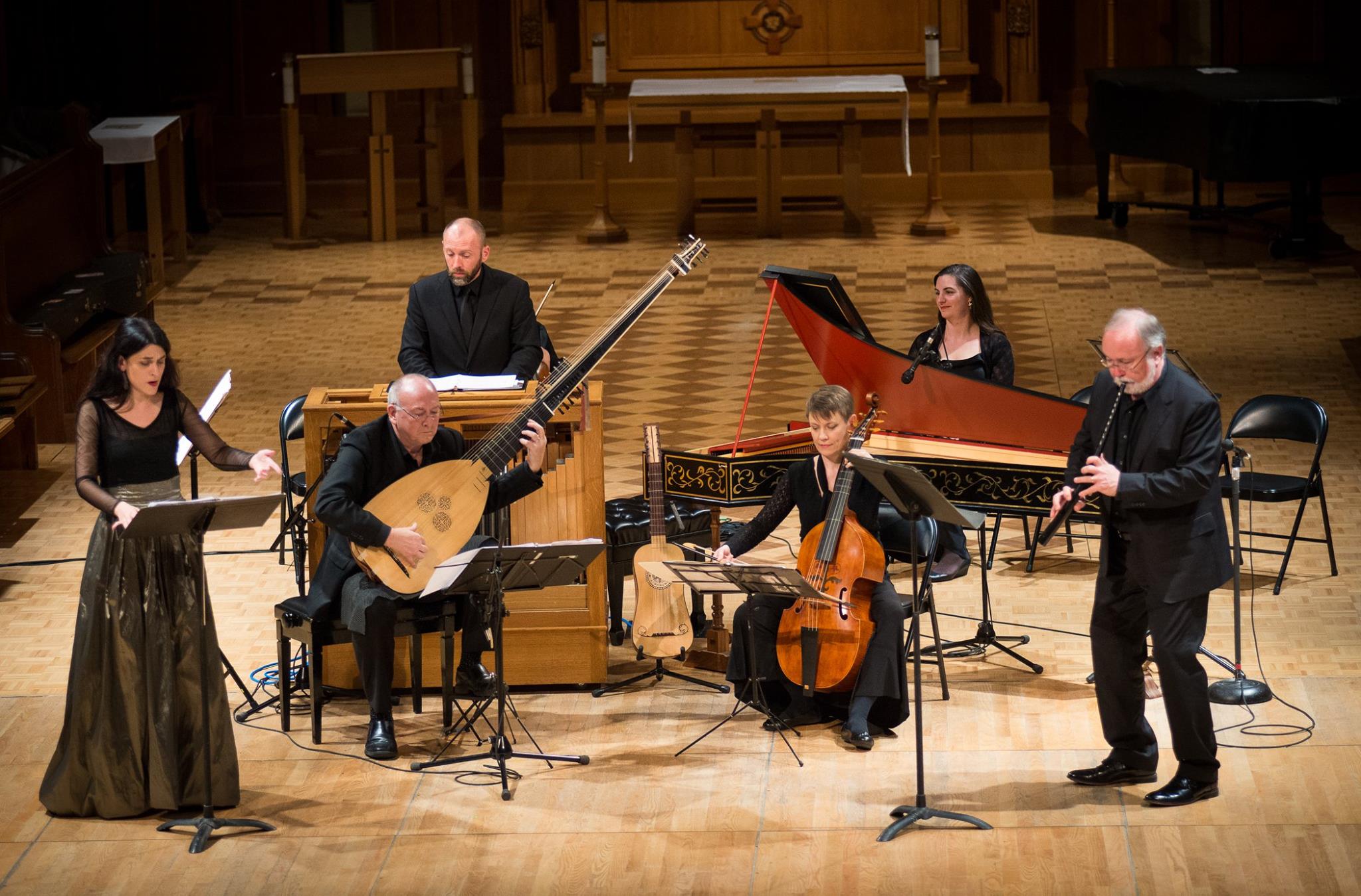 Canada Breathtaking: A Voice and a Cornetto Entwined: Hana Blažíková (soprano), Bruce Dickey (cornetto), Monica Huggett and Tekla Cunningham (violins), Joanna Blendulf (viol), Michael Sponseller (organ and harpsichord), Stephen Stubbs (theorbo and guitar), Christ Church Cathedral, Vancouver, 4.11.2016. (GN)
Canada Breathtaking: A Voice and a Cornetto Entwined: Hana Blažíková (soprano), Bruce Dickey (cornetto), Monica Huggett and Tekla Cunningham (violins), Joanna Blendulf (viol), Michael Sponseller (organ and harpsichord), Stephen Stubbs (theorbo and guitar), Christ Church Cathedral, Vancouver, 4.11.2016. (GN)

Cazzati – ‘Regina coeli’
Corradini – ‘Spargite flores’
Marini – Sonata seconda a doi violini
D’India – ’Dilectus meus’,’ Langue al vostro languir’
Fontana – Sonata 11 a 2
Merula – ‘Nigra Sum’
Carissimi – ‘Summi regis puerpera’
Tsoupaki – ‘Mélena imí’ (‘Nigra sum’)
Bassani – Three arias from La Morte Delusa, Sonata prima a 3, Op.5
A.Scarlatti – Three arias from Emireno
Coinciding with the meetings of the American Musicological Society, and featuring a collection of the world’s finest soloists, this concert was very special. The overriding cause for celebration was hearing Bruce Dickey’s cornetto, in its full and masterful variety, interacting so beautifully with Hana Blažíková’s soprano voice in pre-Corellian Italian repertoire (1630-1680). As the concert’s title suggests, they absolutely fit like a glove and achieved ‘breathtaking’ balance and intimacy. Since the violin and cornetto were also historical competitors, even more was actually going on: with Monica Huggett’s violin also vying for inclusion, the concert revealed the sterling cooperation of all three ‘voices’ within a treble register that could have easily be dominated, or rendered opaque, by any one of them. A distinguished continuo backed it all, and a special treat was hearing Calliope Tsoupaki’s ‘Nigra sum’ for cornetto and voice, composed in 2015. A CD of this exact concert has just been released by Passacaille.
For the past four decades, Bruce Dickey has almost singlehandedly sought to give the cornetto the historical significance it deserves, cultivating a long line of students to perpetuate its claims. From many perspectives, Dickey’s commitment stands as one of the monuments of the revitalization of historical performance. At this concert, he arrived with more than one instrument, allowing a fuller display of the cornetto’s lovely colour and reach. Given the thousands of vocalists Dickey has performed with over the years, it is significant that he regards Hana Blažíková as having the most ‘cornetto-friendly’ voice he has ever encountered. It seems that the key to the singer’s voice is that it is so pure and has so few resonant overtones that it can maintain its exact tonal identity in relation to the cornetto, no matter what the latter is doing and what volume levels are being sustained. This transparency holds even when Blažíková is singing exactly the same notes as the cornetto, or where one is weaving around the lines of the other.
Many of the Italian composers featured are not household names but cast light on an interesting 17th century ‘transition’ in Italian music: all find a cherishable interaction between cornetto and voice. In Maurizio Cazatti’s opening ‘Regina coeli’, a beguiling integration between the two was established on bubbling ascending phrases resolved by beautifully-poised runs. Blažíková’s projection is on the lighter side, but is remarkable insofar as she can sometimes project her sound exactly like a boy soprano and, at other times, like a woodwind instrument. While it is typically felt that the cornetto is the instrument that best approximates the human voice, sometimes I felt the relation went the other way too.
Corradini’s ‘Spargite flores’ introduced both triumphal and pensive moods, bringing out the cornetto’s line and flourish, with Blažíková finding both a celestial radiance and a unique ability to amplify the cornetto’s utterance. Michael Sponseller’s chamber organ brought greater gravity and weight to the ‘Dilectus meus’ and ‘Langue al vostro languir’ of the vaguely-documented composer, Sigismondo D’India. These are both emotionally rich pieces: the first slow and yearning with dignity; the latter finding a sharper anguish and torment. Both artists reveled in the variety of their dialogue, showing remarkable unanimity in the latter piece where they often duplicate each other’s notes. Tarquino Merula’s ‘Nigra sum’ revealed all the pristine pacing and paragraphing that the singer is capable of, enticingly balanced with the cornetto, and absolutely beautiful overall. The same could be said of Carissimi’s wondrous ‘Summi regis puerpera’, with Blažíková perhaps finding even a finer, more subtle lyrical line, truly displaying her voice as an ‘instrument’.
The modern ‘Nigra sum’ by Calliope Tsoupaki, composed last year, was quite stunning, bringing out the sparse, searching tones of both voices, and sometimes exploiting very high sustained notes. With the voice and the cornetto often alternating in an obbligato role, the work creates a great feeling of suspended stillness. It reaches out to the primeval at some points, cultivates a haunting tonal unease at others, yet it ends with the affirmation of an anthem. I cannot visualize a more deeply felt performance.
The concert closed with the three arias from Bassani’s La Morte Delusa, coupled with three arias from Allesandro Scarlatti’s Emerino. Both provided yet further examples of the joint expressiveness and bliss in Blažíková and Dickey’s partnership. While the quality of these arias is uneven, one thing that struck me forcibly was just how natural Blažíková’s singing is. She has a wonderful control of dynamics, and can cut sharply in crescendos, but she never appears ‘practiced’ in her responses to technical challenges. Her execution seems to flow directly from the underlying narrative of the text, and time and time again I thought just how ‘conversational’ the line of her singing was.
There were a number of refreshing instrumental pieces interspersed throughout the concert, showing off a nice variety in the primary soloists. Biagio Marino’s Sonata secunda a doi violini featured Monica Huggett and Tekla Cunningham on violins playing off Stephen Stubbs’ theorbo. This work starts from a somewhat melancholic and distilled fabric but eventually reveals a strong passion underneath: Huggett added considerable rhapsodic thrust and an improvisatory dimension. Giovanni Batista Fontana’s Sonata 11 a 2 found Huggett’s violin ‘at war’ with the cornetto, but they actually complemented each other delightfully in their question and answer. Huggett and Cunningham joined viol Joanna Blendulf in Bassani’s Sonata prima a 5, a most likeable work with great variety. It moved from strong energy and cut and thrust at the opening to considerable romantic feeling in the slow movement, topped off by touching interplay between the soloists at the end.
I do hope that early music aficionados who do not get the chance to hear this unique combination of forces in person can at least sample the CD or videos online.
Geoffrey Newman
Previously published in a slightly different form on http://www.vanclassicalmusic.com.
